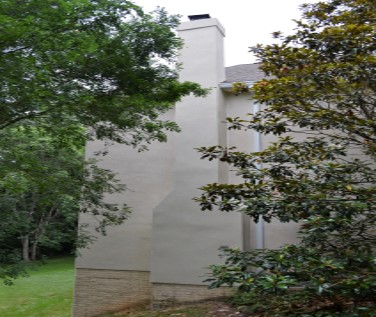
We love that great look the texture of
stucco and plaster can give your home, and no one can argue that it adds a lot of character to any house, but one of the most important reasons we like this kind of surface is that it has some very practical advantages. Stucco and plaster can create a surface that’s seamless, mold-resistant, fire-resistant, and even noise proof! But, every material needs to be cared for over time, and if your plaster or stucco is beginning to crack, it’s time to take action.
Freehand plastering takes a lot of technical skill, but repairs can be just as tricky. Plaster and stucco are often laid on over-complex wall structures (usually plaster on the inside walls and stucco on the outside) that are very hard for an amateur to tackle without damaging
something along the way – and the victim often ends up being the plaster or stucco itself. This only makes the whole process more time-consuming and expensive. Not to mention, each wall is usually different, meaning you’ll need to take a different approach every time. Even if you think you know what you’re doing, your walls can surprise you . . . in a very expensive way.
Stucco also lends unique texture to exterior walls.
Repairing Stucco Saves You Money
If you already have plaster or stucco on your walls, removing it entirely can actually be
more costly than simply calling in the professionals for repair. Even after you take off the surface layer, you’re then faced with the cost of installing an entirely new interior surface. If your home already has plaster or stucco, quality care and upkeep are investments that just make sense.
There are clearly plenty of reasons to have and keep up plaster and stucco walls, but repairing old or damaged surfaces takes the touch of a
skilled craftsman. So what can you do? Call in the pros, of course. Homeowners can avoid messes and mistakes by having an experienced professional handle their repair. Our team can assess the current state of your walls to answer questions like:
- How well is your plaster or stucco attached to its lath (meaning the wooden slats that attach it to the wall’s framework)?
- Is it salvageable at all?
- How is the surface quality?
We will then decide exactly what the best technique is to reattach your layer of stucco or plaster to the lath, repair surface damage, and repaint it to get the exact look you want.
We always look at the size and shape of the cracks since they are a good indicator of what the problem is. Minor stress cracks usually happen because of the typical expanding and contracting that we all know happens with our drastic weather changes. These can be filled in with a strong mesh fabric that expands and contracts with the wall. Larger cracks tend to run diagonally in the middle of a wall and could be as long as three to five feet. Cracks like this generally mean that your surface is pulling away from the lath, sometimes because the lath has warped over the years. We fix this by putting in what’s known as a “plaster button,” a type of washer that can be run through the plaster to secure it to the lath.
If your surface is
really starting to crumble away, we might need to pull it completely off and replace the rotting lath before we apply new plaster or stucco.
Recently though, especially for plaster interiors, we’ve found that many homeowners choose to attach a piece of sheetrock to the wall and lay plaster on in a thinner layer over the sheetrock, instead of completely rebuilding the lath. It’s a good, workable option for a quicker fix.
Whichever approach is the right one for your walls, after we’ve built a strong, solid base, the next step is adding primer to the surface, and then
voilà, ready for painting.
Source:
https://goo.gl/Uh84LW
 We love that great look the texture of stucco and plaster can give your home, and no one can argue that it adds a lot of character to any house, but one of the most important reasons we like this kind of surface is that it has some very practical advantages. Stucco and plaster can create a surface that’s seamless, mold-resistant, fire-resistant, and even noise proof! But, every material needs to be cared for over time, and if your plaster or stucco is beginning to crack, it’s time to take action.
Freehand plastering takes a lot of technical skill, but repairs can be just as tricky. Plaster and stucco are often laid on over-complex wall structures (usually plaster on the inside walls and stucco on the outside) that are very hard for an amateur to tackle without damaging something along the way – and the victim often ends up being the plaster or stucco itself. This only makes the whole process more time-consuming and expensive. Not to mention, each wall is usually different, meaning you’ll need to take a different approach every time. Even if you think you know what you’re doing, your walls can surprise you . . . in a very expensive way.
Stucco also lends unique texture to exterior walls.
We love that great look the texture of stucco and plaster can give your home, and no one can argue that it adds a lot of character to any house, but one of the most important reasons we like this kind of surface is that it has some very practical advantages. Stucco and plaster can create a surface that’s seamless, mold-resistant, fire-resistant, and even noise proof! But, every material needs to be cared for over time, and if your plaster or stucco is beginning to crack, it’s time to take action.
Freehand plastering takes a lot of technical skill, but repairs can be just as tricky. Plaster and stucco are often laid on over-complex wall structures (usually plaster on the inside walls and stucco on the outside) that are very hard for an amateur to tackle without damaging something along the way – and the victim often ends up being the plaster or stucco itself. This only makes the whole process more time-consuming and expensive. Not to mention, each wall is usually different, meaning you’ll need to take a different approach every time. Even if you think you know what you’re doing, your walls can surprise you . . . in a very expensive way.
Stucco also lends unique texture to exterior walls.

